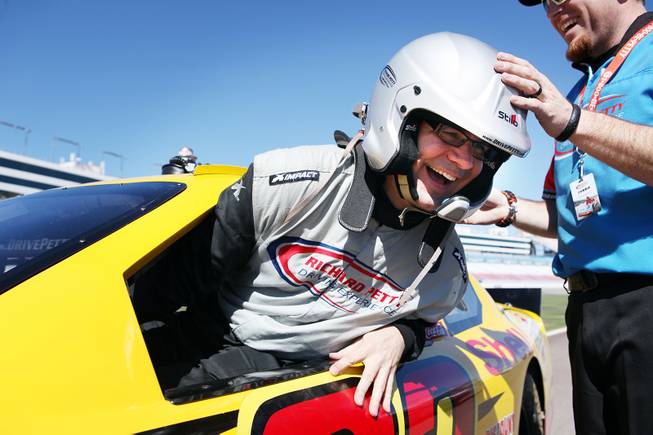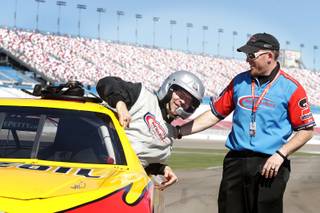
John Katsilometes gets into his race car to drive at the Richard Petty Driving Experience at Las Vegas Motor Speedway on Friday, March 1, 2013.
Thursday, March 7, 2013 | midnight
I have what can be best described as an Issue With the Wall.
It’s the lengthy barrier along the backstretch at Las Vegas Motor Speedway. Appropriately, it is painted in thick black letters reading, “Las Vegas Motor Speedway.”
Those fast-approaching words and that long white wall are to be feared and respected. Anyone who has watched a NASCAR Sprint Cup event on television — the tour hits the speedway this weekend with a series of events capped by Sunday’s Kobalt Tools 400 — knows what can happen if a stock car roaring at 160-190 mph meets up with the wall. Such a collision creates mechanical mayhem, crushed chassis, flying hoods and doors, bounding tires, bursting flames and a for-real day of thunder.
Your brain, or at least mine, observes that immovable barrier coming out of Turn 2 and says, “Stay away from that wall.”
But my driving instructor, seated next to me (having called “Shotgun!” long before our ride), has other ideas.
“Move closer to the wall,” said Mike VanNatta, who has a long history of racing motorcycles and knows a lot about high-powered stock cars, too. “You need to be higher coming out of the turn. Get right up next to it.”
“No freaking way,” is my conscious thought.
But somehow, I spit out, “Gotcha.”
This wall condition is why, among the thousands of drivers who have taken the Richard Petty Driving Experience since it opened with the speedway in 1996, there have been no accidents. It’s nearly unfathomable that not one would-be Jimmie Johnson or Danica Patrick who has signed up for the Petty Experience has actually spun out, rolled or otherwise slammed into inanimate objects at the 1.25-mile track.
But as you take the 30-minute instructional course prior to roaring around the oval, you understand why.
“When people actually get into the car, they realize they don’t want to hit the wall, and they compensate,” says instructor Corrie Mathews, who is guiding this experience.
Brother, you are so right.
In that half-hour, it is explained how to drive one of these beasts around a NASCAR track. The Petty empire operates 20 across the country (the Las Vegas outpost is the busiest, with 250 operating days per year, thanks to agreeable weather and even more agreeable tourists). Richard Petty starts the video by talking of his more than 1,000 NASCAR races and more than 200 victories, and how he is often asked what it feels like to drive a race car. As he says, “You have to experience it.”
Exactly. The King’s key directives: Place your hands at the 10 o’clock and 3 o’clock positions. Keep your vision high to observe the markers on the track — gates, they’re called — that will guide your “line” around the speedway. Keep your acceleration and deceleration smooth. Brake with your right foot, but if you are driving as instructed, the only time you brake is when pulling into the pits.
The six cars at the Petty Experience (mine is a 600-horsepower Dodge Charger) are equipped with four-speed, manual transmissions, and you are to shift at 4,000-rpm increments. I am surprised to learn that in some instances, drivers are push-started onto the track, as not everyone is as educated as I at operating a stick shift.
I happen to be educated that way, which does not explain why I jam the stick from first gear to fourth entering our first lap.
“What happened there?” I ask VanNatta as the car groaned and slowed while I shifted gears entering our first lap.
“You’re in fourth gear,” he says.
“Ah,” I explain. “I must be in a hurry.”
We take eight laps, enter the pits for a review and finish with 10 more.
Right away, I encounter the Issue With the Wall. What is unexpected about these cars, which are loud and uncomfortable and carry the exhaustive fragrance of any Pep Boys garage, is how they are aligned. They pull hard to the left, as the suspension is set up for continual left turns. But you do not always pull the steering wheel (which is detachable, reminding you that this is not exactly an off-the-showroom vehicle) to the left. Coming into the back straightaway, you do turn slightly right.
I’ve often referred to Las Vegas Motor Speedway as the Land of Left Turns, but it turns out that is not entirely correct. VanNatta notes this, saying, “I notice when I tell you to get high on the track, your arms start right — then stop.”
“It’s not that I don’t trust you. It’s this wall thing.”
There is also a visibility issue. As we take the course in the early afternoon and face the sun entering Turn 1 off the front straightaway, I squint to find the gates I need to drive through to maintain my line. But I miss the orange deceleration cones, which mark the moment you are to ease off the throttle, entirely. For, like, three laps.
Calmly but pointedly, VanNatta says, “You are accelerating right through the deceleration cones.”
“There is a deceleration cone there?” I reply. “Wow.”
At the eight-lap break we determine that I need to make sure to hit the gates consistently, and to accelerate and decelerate as directed. By the end, I get the hang of it, or almost do, but am disappointed in my top lap average speed of 131 mph. In competition, these cars approach 200 mph.
“Gosh, I hit 145 mph on my way out here,” I claimed, to widespread disbelief. But you do feel the physical force of pressure after driving even 18 laps. How these drivers can maintain their physical and mental focus over a four-hour race is nothing short of remarkable. The in-car TV cameras used in NASCAR coverage provide an accurate sense of speed — how fast that wall approaches — but nothing of the physical and mental strain you experience when driving one of these cars.
A few minutes after the drive, I talk on the phone to the company CEO, Rick Fedrizzi, and I tell him with great candor, “Forgive my disposition, but I am pretty dizzy.” But I do manage to ask about the value of the Richard Petty name and brand, as Petty himself has not been an active driver in more than two decades.
“What we’ve found when we compare Richard Petty with other drivers, he has been able to maintain his identity with fans,” Fedrizzi says. “He is still one of the most popular drivers, and we feel we have the Babe Ruth of this sport, and he still resonates with a large number of people.”
The attraction is especially busy during race week, with a head-spinning 150 spots reserved just on Monday. Packages range from a three-lap ride-along for $109 to what is known as a Racing Experience of 50 laps around the tri-oval that runs $2,700. In between those vast pricing gates is an eight-lap driving package (the Rookie Experience) that Nevada residents with valid ID can purchase for $299, and locals also get a break on the three-lap ride-along at $79.
Not enough? On March 29, the Petty Experience is adding an American Muscle Car Challenge package, where for $199 drivers can navigate a Dodge Challenger SRT8 392, Ford Mustang Shelby GT500 and Chevrolet Camaro ZL1 over a four-turn road course. And this does not include what is offered during a Fantasy Racing Camp NASCAR Kobalt Tools race weekend: Four days of racing at the facility’s 3.8-mile Bullring, the 1.5-mile road course and the NASCAR oval.
Scheduled to attend the Fantasy Camp are racing luminaries Randy LaJoie, Dale Inman and Petty himself. Maybe I’ll make it out there to talk to the King, and ask him how long it took him to nuzzle up to the wall.
Follow John Katsilometes on Twitter at Twitter.com/JohnnyKats. Also, follow “Kats With the Dish” at Twitter.com/KatsWiththeDish.



Join the Discussion:
Check this out for a full explanation of our conversion to the LiveFyre commenting system and instructions on how to sign up for an account.
Full comments policy